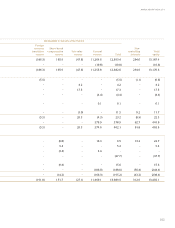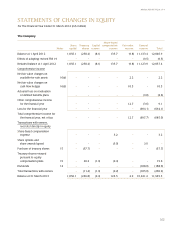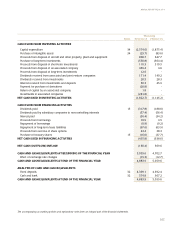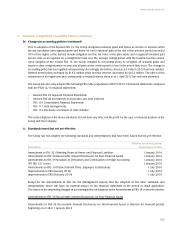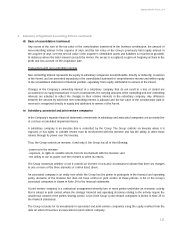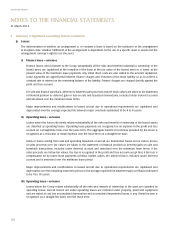Singapore Airlines 2014 Annual Report Download - page 113
Download and view the complete annual report
Please find page 113 of the 2014 Singapore Airlines annual report below. You can navigate through the pages in the report by either clicking on the pages listed below, or by using the keyword search tool below to find specific information within the annual report.
111
ANNUAL REPORT FY2013/14
2 Summary of Significant Accounting Policies (continued)
(d) Basis of consolidation (continued)
Any excess of the sum of the fair value of the consideration transferred in the business combination, the amount of
non-controlling interest in the acquiree (if any), and the fair value of the Group’s previously held equity interest in
the acquiree (if any), over the net fair value of the acquiree’s identifiable assets and liabilities is recorded as goodwill.
In instances where the latter amount exceeds the former, the excess is recognised as gain on bargain purchase in the
profit and loss account on the acquisition date.
Transactions with non-controlling interests
Non-controlling interest represents the equity in subsidiary companies not attributable, directly or indirectly, to owners
of the Parent, and are presented separately in the consolidated statement of comprehensive income and within equity
in the consolidated statement of financial position, separately from equity attributable to owners of the Parent.
Changes in the Company’s ownership interest in a subsidiary company that do not result in a loss of control are
accounted for as equity transactions. In such circumstances, the carrying amounts of the controlling and non-controlling
interests are adjusted to reflect the changes in their relative interests in the subsidiary company. Any difference
between the amount by which the non-controlling interest is adjusted and the fair value of the consideration paid or
received is recognised directly in equity and attributed to owners of the Parent.
(e) Subsidiary,associatedandjointventurecompanies
In the Company’s separate financial statements, investments in subsidiary and associated companies are accounted for
at cost less accumulated impairment losses.
A subsidiary company is an investee that is controlled by the Group. The Group controls an investee when it is
exposed, or has rights, to variable returns from its involvement with the investee and has the ability to affect those
returns through its power over the investee.
Thus, the Group controls an investee, if and only if, the Group has all of the following:
- power over the investee
- exposure, or rights to variable returns from its involvement with the investee; and
- the ability to use its power over the investee to affect its returns
The Group reassesses whether or not it controls an investee if facts and circumstances indicate that there are changes
to one or more of the three elements of control listed above.
An associated company is an entity over which the Group has the power to participate in the financial and operating
policy decisions of the investee but does not have control or joint control of those policies. A list of the Group’s
associated companies is shown in Note 24 to the financial statements.
A joint venture company is a contractual arrangement whereby two or more parties undertake an economic activity
that is subject to joint control, where the strategic financial and operating decisions relating to the activity require the
unanimous consent of the parties sharing control. A list of the Group’s joint venture companies is shown in Note 25 to
the financial statements.
The Group accounts for its investments in associated and joint venture companies using the equity method from the
date on which it becomes an associated or joint venture company.




